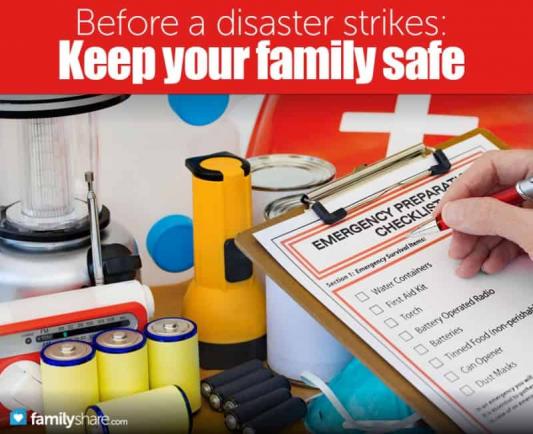
I recently completed a Community Emergency Response Team, CERT, course. We live in a hurricane prone area, and within the boundaries of a nuclear plant, so some of the things they discussed for family safety are already in place for our family.
-
72-hour kits in grab and go bags ready if ordered to evacuate. Check the Disaster Supply Kit checklist for recommended supplies and adjust according to your family's needs. Don't forget comfort foods.
-
An escape route, with alternatives, and a meeting place. You need a meet-up place in case your family is separated. The location may vary depending on what you are running from.
-
Select, with their permission, an out of the area family member or friend as your "out of the area" contact. You will keep this person informed about where you are and your status during an emergency. They will pass this information on to concerned friends and family.
-
Make transportation arrangements. If you own a car, keep it near full of gas. If you're leaving before a disaster, lines may be unmanageable or supplies low or out. If you're leaving after, gas may not be available. If you don't own a car, make arrangements with local family or friends and know your local government's evacuation transportation plans.
-
If you have children in school, know their evacuation rules. As stated, we live near a nuclear plant. During a nuclear disaster all local schools lockdown and bus the children to locations north. Parents must wait until their children are relocated to pick them up. Parents cannot get on their local school campuses.
As a CERT member, we were told we couldn't join a team until we knew our families were safe. They know our effectiveness as a responder would be compromised if our thoughts were of our families. We followed their advice and re-evaluated our home for unsecured hazards that could result in a family member being hurt.
Identify potential hazards in your home
Check cupboards in your kitchen, bathrooms, laundry area, garage and shed as well as workbenches for potential hazards. This includes common household chemicals. Reduce or remove them.
Do you still need the material? Is it stored safely and away from children, pets and food? Are they located in unfastened cabinets that may fall? Many chemicals do not mix well. Check here for common household chemicals and unsafe mixtures.
I remember my mother telling us about my sister's kindergarten teacher. She almost died when she mixed ammonia and bleach in her washing machine. Imagine if they fell in your laundry room and you didn't discover it until a family member was injured by its poisonous gas. Keep potentially harmful chemicals separate.
Check your utilities
-
Water heaters, dryers and stoves should have flexible lines. This helps prevent breakage from shaking, floods or wind.
-
Electric shock could result from displaced appliances and office equipment. Secure them where possible or unplug them when not.
-
Look for faulty wiring, frayed electrical cords and overloaded electrical outlets and extension cords. Never hook one extension cord to another. Purchase a longer cord. When we did this, we found broken and missing outlet covers. They have been replaced.
-
Are you in a flood zone? Look for utility boxes and outlets below flood levels.
Look for unsecured heavy furniture, heavy objects on tabletops and on open shelves, especially in earthquake and flood prone areas. Note locations of mirrors and pictures on walls, especially above beds and couches.
Fix potential hazards
Walk room-by-room. Make a plan to:
-
Secure bookshelves, hutches and cabinets to wall studs.
-
Strap water heaters to wall studs.
-
Install flexible hoses to avoid gas and water leaks.
-
Secure office equipment with industrial strength Velcro®.
-
Install childproof fasteners to drawers and cabinet doors.
-
Use earthquake-resistant hooks to hang pictures and mirrors.
-
Secure propane tanks.
-
Replace faulty wiring and frayed electrical cords.
-
Untangle and solve overloaded outlets. Move electrical appliances or equipment to different locations, or have an electrician install more outlets and, if necessary, breakers.
-
Find different outlets or additional extension cords for equipment using over-loaded extension cords. Remember, extension cords are only for temporary use.
-
Raise utility boxes and outlets above flood levels.
Organize this list in order starting with the greatest need, and fix the hazards as soon as possible. Hire professionals, if needed. Do not attempt to remedy a potential hazard not in your area of expertise.
Identifying potential hazards and fixing them will give you peace of mind. You and your family will be safer; you will have eliminated some potential manmade disasters and be safer during a natural disaster.
For more information, click on the following websites, FEMA, The American Red Cross and The Centers for Disease Control and Prevention, for national information on pandemic influenza.

